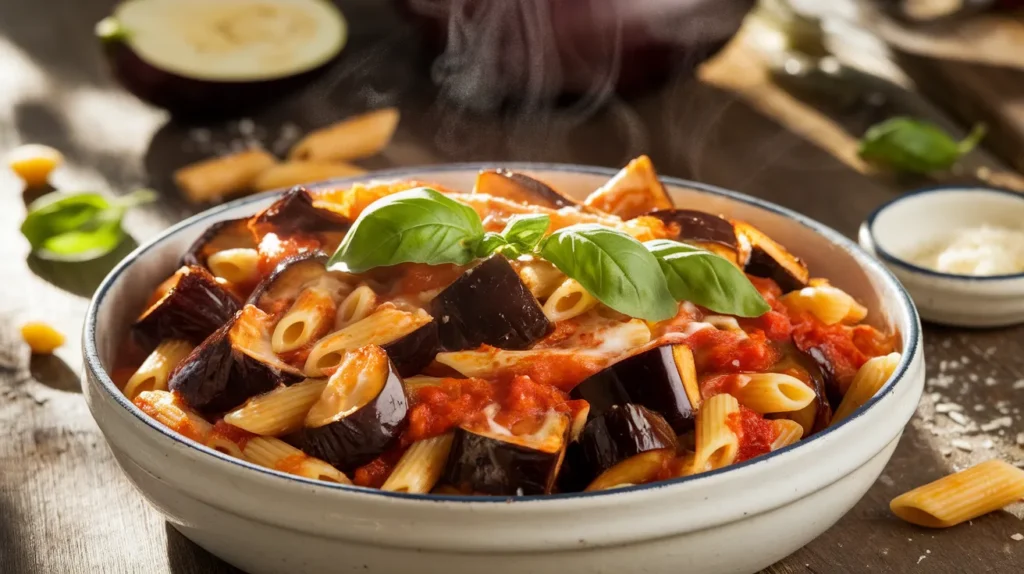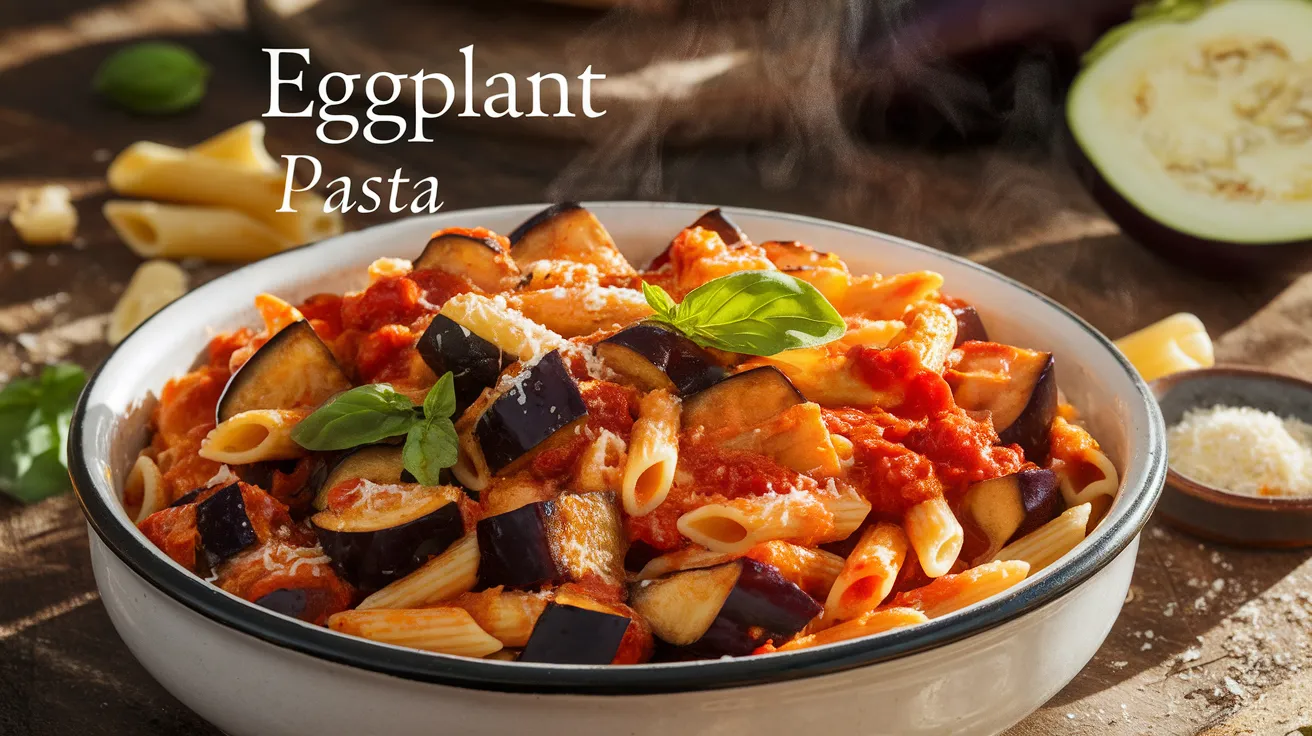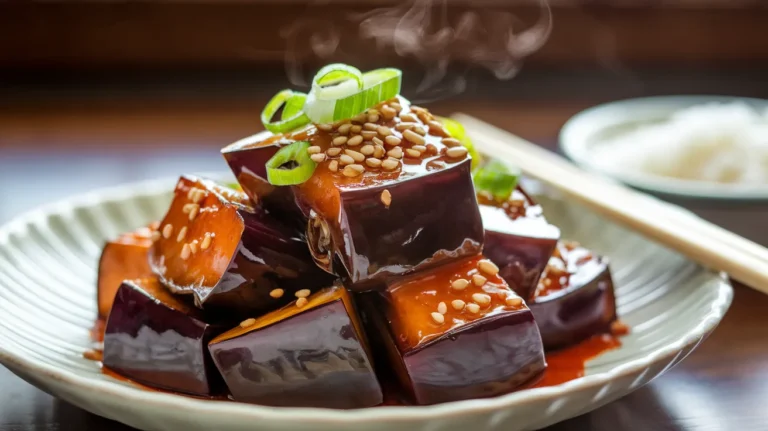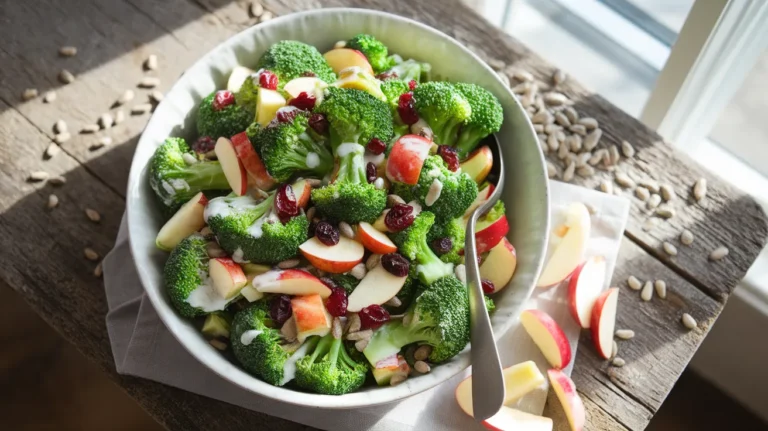This rich eggplant pasta combines tender, caramelized eggplant with aromatic herbs and garlic for a satisfying Mediterranean-inspired meal. Perfect for busy weeknights, this eggplant pasta recipe transforms simple ingredients into restaurant-quality comfort food that even skeptics will love.
SERVES: 4 | PREP: 15 MIN | COOK: 25 MIN | TOTAL: 40 MIN
Ingredients
Main Components
| Ingredient | Amount | Notes |
|---|---|---|
| Large eggplant | 1 (about 1.5 lbs) | Choose firm, glossy skin |
| Penne or rigatoni pasta | 12 oz | Short pasta holds sauce best |
| Extra virgin olive oil | 1/3 cup | Don’t skimp – it’s essential |
| Garlic cloves | 4 large | Minced fine |
| Yellow onion | 1 medium | Diced |
Flavor Builders
| Ingredient | Amount | Purpose |
|---|---|---|
| Crushed tomatoes | 1 (14 oz) can | Creates rich base |
| Fresh basil leaves | 1/2 cup | Torn, not chopped |
| Parmesan cheese | 1 cup | Freshly grated |
| Red pepper flakes | 1/2 tsp | Adds gentle heat |
| Kosher salt | 2 tsp | For eggplant prep |
| Black pepper | 1/2 tsp | Freshly ground |
Step-by-Step Instructions
Phase 1: Eggplant Preparation (10 minutes)
1. Cut the eggplant into 3/4-inch cubes, leaving skin on for texture and color. The cubes should be uniform so they cook evenly.
2. Place cubed eggplant in a large colander and toss with 2 teaspoons kosher salt. This draws out bitter juices and prevents mushy texture. Let sit for 10 minutes while you prep other ingredients.
3. Pat the salted eggplant completely dry with paper towels. This step is crucial – wet eggplant will steam instead of browning, giving you soggy results instead of the golden, caramelized pieces we want.
Phase 2: Building the Base (8 minutes)
4. Heat a large pot of salted water to boiling for pasta. Use about 1 tablespoon salt per quart of water – it should taste like mild seawater.
5. Heat 3 tablespoons olive oil in a large skillet over medium-high heat. The oil should shimmer but not smoke – that’s your perfect temperature indicator.
6. Add the dried eggplant cubes to the hot oil in a single layer. Don’t overcrowd or they’ll steam. Cook without stirring for 4-5 minutes until golden brown on one side.
7. Flip eggplant pieces and cook another 3-4 minutes until tender throughout and golden on all sides. The pieces should feel soft when pierced with a fork but hold their shape.
Phase 3: Sauce Development (7 minutes)
8. Push eggplant to one side of the skillet and add remaining olive oil to the empty space. Add minced garlic and diced onion to the oil.
9. Cook the garlic and onion for 2-3 minutes until fragrant and the onion turns translucent. Stir constantly to prevent garlic from burning, which would make it bitter.
10. Mix the eggplant back with the aromatics and add crushed tomatoes, red pepper flakes, and black pepper. The mixture should bubble gently.
11. Reduce heat to low and simmer for 5-7 minutes, stirring occasionally. The sauce should thicken slightly and the flavors should meld together.
Phase 4: Pasta and Final Assembly (10 minutes)
12. Add pasta to the boiling water and cook according to package directions minus 1 minute. We want it slightly underdone since it’ll finish cooking in the sauce.
13. Reserve 1 cup pasta cooking water before draining. This starchy water will help bind the sauce to the pasta perfectly.
14. Add the drained pasta directly to the skillet with the eggplant mixture. Toss everything together over low heat.
15. Add 1/2 cup pasta water and half the Parmesan cheese. Toss vigorously for 2-3 minutes until the pasta is well-coated and the sauce clings to each piece.
16. Remove from heat and fold in torn basil leaves and remaining Parmesan. Add more pasta water if needed to achieve a silky, not dry consistency.
17. Taste and adjust seasoning with salt and pepper. The dish should be well-seasoned but let the eggplant’s natural sweetness shine through.
18. Serve immediately in warm bowls with extra Parmesan and fresh basil on the side.
Chef’s Notes
Eggplant Selection: Choose eggplants that feel heavy for their size with smooth, glossy skin. Avoid any with soft spots or wrinkled areas, as these indicate the eggplant is past its prime.
Salt Timing: Don’t skip the salting step – it removes bitterness and prevents the eggplant pasta from becoming watery. The 10-minute wait is worth the improved texture.
Oil Temperature: Keep your oil hot enough to sear the eggplant but not so hot it burns. You want that beautiful golden caramelization that adds depth to your eggplant pasta.
Pasta Water Magic: The starchy pasta water acts as a natural thickener and helps create that restaurant-quality sauce consistency that coats every piece perfectly.
Nutrition Information (Per Serving)
- Calories: 485
- Protein: 16g
- Carbohydrates: 68g
- Fat: 18g
- Fiber: 8g
- Sodium: 620mg
Delicious Variations
Mediterranean Style: Add kalamata olives, sun-dried tomatoes, and crumbled feta cheese for a Greek-inspired twist that pairs beautifully with the eggplant base.
Protein Boost: Incorporate Italian sausage or grilled chicken in the final steps. For vegetarian protein, cannellini beans work wonderfully and complement the Mediterranean flavors.
Creamy Version: Stir in 1/2 cup heavy cream during the final tossing stage for a rich, indulgent sauce that turns this into comfort food heaven.
Roasted Eggplant Twist: For deeper flavor, try this technique from our eggplant parmesan recipe – roast the eggplant cubes in the oven at 425°F for 20 minutes before adding to the sauce.
Storage & Reheating
Refrigeration: Store leftover eggplant pasta in the refrigerator for up to 4 days in an airtight container. The flavors actually improve overnight as they meld together.
Reheating: Add a splash of water or broth when reheating to restore the sauce consistency. Heat gently in a covered pan over low heat, stirring frequently.
Freezing: This dish freezes well for up to 3 months. Thaw overnight in the refrigerator before reheating. You may need to add extra liquid and cheese to refresh the sauce.
Make-Ahead: You can prepare the eggplant and sauce up to 2 days ahead. Store separately and combine with freshly cooked pasta when ready to serve.

Troubleshooting Common Issues
Problem: Mushy eggplant Solution: Make sure to salt the eggplant properly and pat it completely dry. Cook over high enough heat to achieve browning rather than steaming.
Problem: Bitter taste Solution: This usually means the eggplant wasn’t salted long enough or the garlic burned. Always salt for the full 10 minutes and watch garlic carefully.
Problem: Dry, clumpy pasta Solution: You need more pasta cooking water to create the silky sauce. Add it gradually while tossing until you achieve the right consistency.
Problem: Sauce won’t stick to pasta Solution: Make sure your pasta is slightly underdone when you add it to the sauce, and toss vigorously with pasta water to create the proper emulsion.
Problem: Bland overall flavor Solution: The dish likely needs more salt and Parmesan cheese. Also, make sure your eggplant is properly browned for maximum flavor development.
Equipment Essentials
- Large skillet or wide sauté pan (at least 12-inch)
- Large pot for boiling pasta
- Colander for draining eggplant and pasta
- Sharp chef’s knife for clean eggplant cuts
- Cutting board (preferably large)
- Wooden spoon or pasta fork for tossing
- Measuring cups and spoons
- Paper towels for drying eggplant
Shopping List
Produce Section
- 1 large eggplant (about 1.5 lbs)
- 1 medium yellow onion
- 1 head fresh garlic
- 1 bunch fresh basil
Pantry Items
- 12 oz penne or rigatoni pasta
- Extra virgin olive oil
- 1 can (14 oz) crushed tomatoes
- Red pepper flakes
- Kosher salt
- Black pepper
Dairy Section
- 8 oz block Parmesan cheese (for grating)
Success Secrets
1. Always salt your eggplant and wait the full 10 minutes – this single step separates amateur from professional results in any eggplant pasta dish.
2. Get your eggplant properly browned before adding other ingredients. Those caramelized edges provide incredible depth of flavor that raw or steamed eggplant simply can’t match.
3. Save that pasta water! It’s liquid gold for creating silky, restaurant-quality sauces that cling perfectly to every piece of pasta.
4. Finish cooking the pasta in the sauce rather than just mixing them together. This allows the pasta to absorb flavors and creates better integration.
5. Fresh basil goes in at the very end to preserve its bright color and aromatic oils. Cooked basil becomes dull and loses its magic, so timing matters here.
For more eggplant inspiration, check out our popular [eggplant pizza](https://daniblogger.com/eggplant pizza) recipe that uses similar flavor principles in a completely different format.




